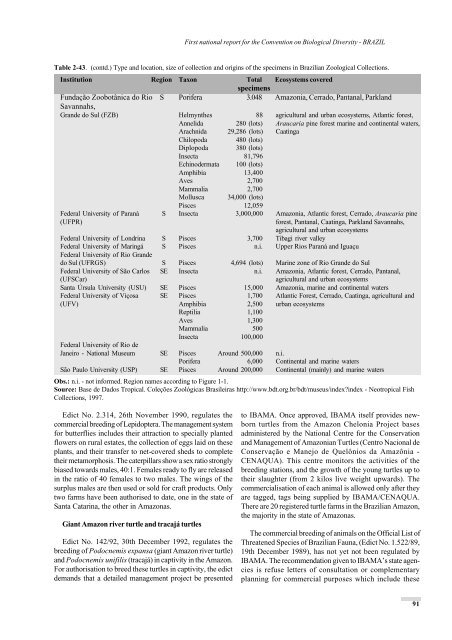Brazil (Part VIII, English version) - Convention on Biological Diversity
Brazil (Part VIII, English version) - Convention on Biological Diversity
Brazil (Part VIII, English version) - Convention on Biological Diversity
- No tags were found...
Create successful ePaper yourself
Turn your PDF publications into a flip-book with our unique Google optimized e-Paper software.
First nati<strong>on</strong>al report for the <str<strong>on</strong>g>C<strong>on</strong>venti<strong>on</strong></str<strong>on</strong>g> <strong>on</strong> <strong>Biological</strong> <strong>Diversity</strong> - BRAZILTable 2-43. (c<strong>on</strong>td.) Type and locati<strong>on</strong>, size of collecti<strong>on</strong> and origins of the specimens in <str<strong>on</strong>g>Brazil</str<strong>on</strong>g>ian Zoological Collecti<strong>on</strong>s.Instituti<strong>on</strong> Regi<strong>on</strong> Tax<strong>on</strong> Total Ecosystems coveredspecimensFundação Zoobotânica do Rio S Porifera 3.048 Amaz<strong>on</strong>ia, Cerrado, Pantanal, ParklandSavannahs,Grande do Sul (FZB) Helmynthes 88 agricultural and urban ecosystems, Atlantic forest,Annelida 280 (lots) Araucaria pine forest marine and c<strong>on</strong>tinental waters,Arachnida 29,286 (lots) CaatingaChilopoda 480 (lots)Diplopoda 380 (lots)Insecta 81,796Echinodermata 100 (lots)Amphibia 13,400Aves 2,700Mammalia 2,700Mollusca 34,000 (lots)Pisces 12,059Federal University of Paraná S Insecta 3,000,000 Amaz<strong>on</strong>ia, Atlantic forest, Cerrado, Araucaria pine(UFPR)forest, Pantanal, Caatinga, Parkland Savannahs,agricultural and urban ecosystemsFederal University of L<strong>on</strong>drina S Pisces 3,700 Tibagi river valleyFederal University of Maringá S Pisces n.i. Upper Rios Paraná and IguaçuFederal University of Rio Grandedo Sul (UFRGS) S Pisces 4,694 (lots) Marine z<strong>on</strong>e of Rio Grande do SulFederal University of São Carlos SE Insecta n.i. Amaz<strong>on</strong>ia, Atlantic forest, Cerrado, Pantanal,(UFSCar)agricultural and urban ecosystemsSanta Úrsula University (USU) SE Pisces 15,000 Amaz<strong>on</strong>ia, marine and c<strong>on</strong>tinental watersFederal University of Viçosa SE Pisces 1,700 Atlantic Forest, Cerrado, Caatinga, agricultural and(UFV) Amphibia 2,500 urban ecosystemsReptilia 1,100Aves 1,300Mammalia 500Insecta 100,000Federal University of Rio deJaneiro - Nati<strong>on</strong>al Museum SE Pisces Around 500,000 n.i.Porifera 6,000 C<strong>on</strong>tinental and marine watersSão Paulo University (USP) SE Pisces Around 200,000 C<strong>on</strong>tinental (mainly) and marine watersObs.: n.i. - not informed. Regi<strong>on</strong> names according to Figure 1-1.Source: Base de Dados Tropical. Coleções Zoológicas Brasileiras http://www.bdt.org.br/bdt/museus/index?index - Neotropical FishCollecti<strong>on</strong>s, 1997.Edict No. 2.314, 26th November 1990, regulates thecommercial breeding of Lepidoptera. The management systemfor butterflies includes their attracti<strong>on</strong> to specially plantedflowers <strong>on</strong> rural estates, the collecti<strong>on</strong> of eggs laid <strong>on</strong> theseplants, and their transfer to net-covered sheds to completetheir metamorphosis. The caterpillars show a sex ratio str<strong>on</strong>glybiased towards males, 40:1. Females ready to fly are releasedin the ratio of 40 females to two males. The wings of thesurplus males are then used or sold for craft products. Onlytwo farms have been authorised to date, <strong>on</strong>e in the state ofSanta Catarina, the other in Amaz<strong>on</strong>as.Giant Amaz<strong>on</strong> river turtle and tracajá turtlesEdict No. 142/92, 30th December 1992, regulates thebreeding of Podocnemis expansa (giant Amaz<strong>on</strong> river turtle)and Podocnemis unifilis (tracajá) in captivity in the Amaz<strong>on</strong>.For authorisati<strong>on</strong> to breed these turtles in captivity, the edictdemands that a detailed management project be presentedto IBAMA. Once approved, IBAMA itself provides newbornturtles from the Amaz<strong>on</strong> Chel<strong>on</strong>ia Project basesadministered by the Nati<strong>on</strong>al Centre for the C<strong>on</strong>servati<strong>on</strong>and Management of Amaz<strong>on</strong>ian Turtles (Centro Naci<strong>on</strong>al deC<strong>on</strong>servação e Manejo de Quelônios da Amazônia -CENAQUA). This centre m<strong>on</strong>itors the activities of thebreeding stati<strong>on</strong>s, and the growth of the young turtles up totheir slaughter (from 2 kilos live weight upwards). Thecommercialisati<strong>on</strong> of each animal is allowed <strong>on</strong>ly after theyare tagged, tags being supplied by IBAMA/CENAQUA.There are 20 registered turtle farms in the <str<strong>on</strong>g>Brazil</str<strong>on</strong>g>ian Amaz<strong>on</strong>,the majority in the state of Amaz<strong>on</strong>as.The commercial breeding of animals <strong>on</strong> the Official List ofThreatened Species of <str<strong>on</strong>g>Brazil</str<strong>on</strong>g>ian Fauna, (Edict No. 1.522/89,19th December 1989), has not yet not been regulated byIBAMA. The recommendati<strong>on</strong> given to IBAMA’s state agenciesis refuse letters of c<strong>on</strong>sultati<strong>on</strong> or complementaryplanning for commercial purposes which include these91
















